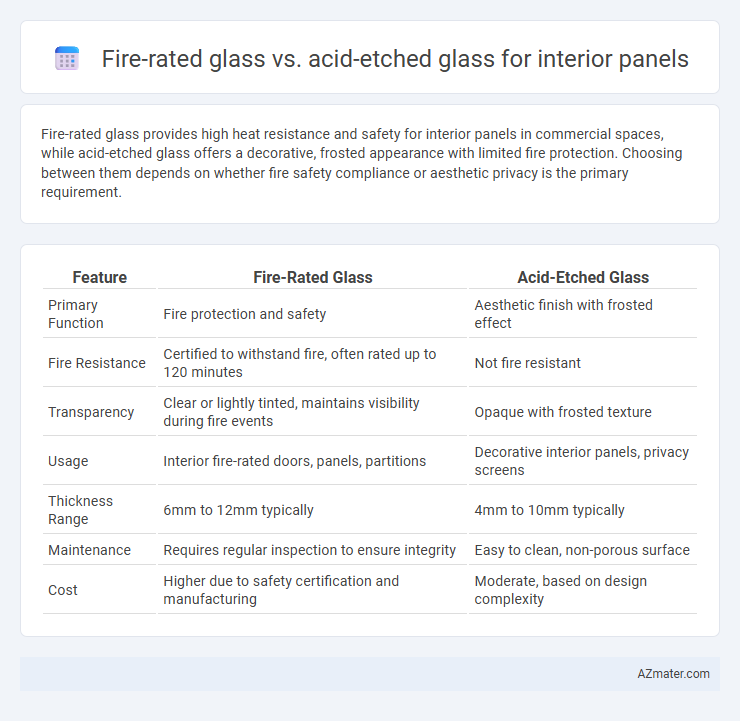Fire-rated glass provides high heat resistance and safety for interior panels in commercial spaces, while acid-etched glass offers a decorative, frosted appearance with limited fire protection. Choosing between them depends on whether fire safety compliance or aesthetic privacy is the primary requirement.
Table of Comparison
| Feature | Fire-Rated Glass | Acid-Etched Glass |
|---|---|---|
| Primary Function | Fire protection and safety | Aesthetic finish with frosted effect |
| Fire Resistance | Certified to withstand fire, often rated up to 120 minutes | Not fire resistant |
| Transparency | Clear or lightly tinted, maintains visibility during fire events | Opaque with frosted texture |
| Usage | Interior fire-rated doors, panels, partitions | Decorative interior panels, privacy screens |
| Thickness Range | 6mm to 12mm typically | 4mm to 10mm typically |
| Maintenance | Requires regular inspection to ensure integrity | Easy to clean, non-porous surface |
| Cost | Higher due to safety certification and manufacturing | Moderate, based on design complexity |
Introduction to Fire-Rated Glass and Acid-Etched Glass
Fire-rated glass is specially engineered to resist high temperatures and prevent the spread of fire, making it essential for safety in interior panels of commercial and residential buildings. Acid-etched glass features a frosted, textured surface created by treating the glass with hydrofluoric acid, offering privacy and decorative appeal without compromising light transmission. Choosing between fire-rated and acid-etched glass depends on balancing safety requirements with aesthetic preferences for interior design.
Key Differences Between Fire-Rated and Acid-Etched Glass
Fire-rated glass is specifically engineered to withstand high temperatures and prevent the spread of fire, making it essential for safety in commercial and residential buildings, whereas acid-etched glass is primarily designed for decorative purposes, offering frosted, translucent surfaces with no fire resistance. Fire-rated glass meets strict regulatory standards such as UL 9 or BS 476, incorporating specialized layers like intumescent interlayers to maintain integrity during fire exposure. In contrast, acid-etched glass achieves its matte finish through chemical treatment, providing privacy and aesthetic appeal without enhancing structural safety or fire protection.
Safety and Fire Protection Capabilities
Fire-rated glass offers superior safety and fire protection capabilities by effectively withstanding high temperatures and preventing the spread of flames and smoke, making it ideal for interior panels in fire-prone areas. Acid-etched glass, while aesthetically pleasing with its frosted, semi-opaque finish, lacks fire-resistant properties and does not provide the same level of protection against heat or fire hazards. Choosing fire-rated glass for interior panels significantly enhances building safety by complying with fire codes and reducing the risk of fire-related damage and injuries.
Visual Aesthetics and Light Transmission
Fire-rated glass offers superior safety features with clear visibility and high light transmission, making it ideal for maintaining brightness and openness in interior panels. Acid-etched glass provides a frosted, matte appearance that enhances privacy and softens light diffusion but reduces overall light transmission compared to clear fire-rated glass. When balancing visual aesthetics and light flow, fire-rated glass preserves transparency and brightness, while acid-etched glass delivers subtle texture and diffused illumination.
Privacy Levels Offered by Each Glass Type
Fire-rated glass provides limited privacy due to its clear or lightly frosted surface, allowing visibility while ensuring safety in fire situations. Acid-etched glass offers higher privacy levels by diffusing light and obscuring vision, making it ideal for confidential interior panels. Selecting between the two depends on the balance needed between fire protection and visual privacy in interior design.
Durability and Maintenance Considerations
Fire-rated glass offers superior durability by withstanding high temperatures and preventing fire spread, making it ideal for safety-critical interior panels. Acid-etched glass, while aesthetically pleasing with a frosted finish, is more prone to surface scratches and requires careful cleaning to maintain its appearance. Maintenance for fire-rated glass centers on regular inspections to ensure integrity, whereas acid-etched glass demands gentle, non-abrasive cleaning to preserve its texture and finish.
Installation Requirements for Interior Panels
Fire-rated glass requires precise installation involving fire-resistant framing systems and intumescent seals to ensure compliance with safety standards and maintain fire integrity. Acid-etched glass for interior panels demands careful handling to preserve its delicate surface finish but allows more flexibility with standard glazing methods and framing materials. Both types must be installed by professionals familiar with their specific requirements to achieve durability and aesthetic appeal.
Cost Comparison: Fire-Rated vs Acid-Etched Glass
Fire-rated glass generally commands a higher price due to its specialized manufacturing process and compliance with stringent safety standards, often costing two to three times more than acid-etched glass. Acid-etched glass offers a more affordable option for interior panels by providing aesthetic frosted finishes without the need for extensive fire-resistance properties. Budget-conscious projects prioritize acid-etched glass for cost efficiency, while fire-rated glass is essential where building codes demand enhanced flame retardance and safety.
Best Applications for Each Glass Type in Interiors
Fire-rated glass is ideal for interior panels in commercial buildings requiring enhanced safety and fire protection, such as corridors, stairwells, and office partitions where meeting fire codes is critical. Acid-etched glass excels in decorative applications like privacy screens, conference room walls, and retail displays, offering a frosted appearance that diffuses light while maintaining an elegant aesthetic. Choosing between these glass types depends on balancing safety requirements with design preferences in interior environments.
Choosing the Right Glass Panel for Your Interior Project
Fire-rated glass offers enhanced safety by providing heat resistance and preventing fire and smoke spread, making it essential for interior panels in commercial and high-risk environments. Acid-etched glass delivers a decorative, frosted appearance with privacy and light diffusion but lacks fire resistance properties. Choosing the right glass panel depends on project requirements where fire safety codes prioritize fire-rated glass, while aesthetic and privacy goals favor acid-etched glass.

Infographic: Fire-rated glass vs Acid-etched glass for Interior panel
 azmater.com
azmater.com